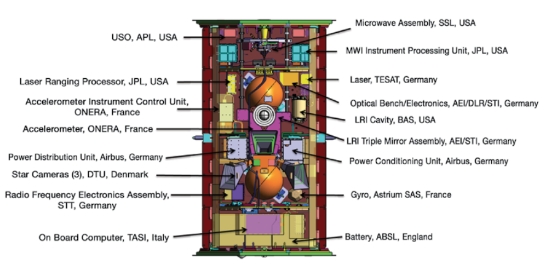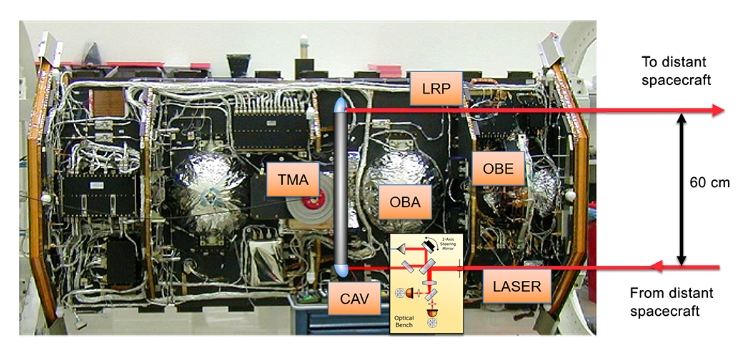ATTITUDE AND ORBIT CONTROL SYSTEM
The satellite’s “attitude,” or orientation and orbit control, are controlled by a system consisting of sensors, actuators and software. The Attitude and Orbit Control System provides three-axis stabilized Earth-pointing attitude control during all mission modes and measures spacecraft rates and orbital position. It features numerous improvements from the GRACE design. The system consists of a GPS receiver, Star Tracker Assembly, coarse Earth and sun sensor, fluxgate magnetometer, inertial measurement unit, magnetic torquers and a cold gas propulsion system.
The GPS receivers are used as references to determine the precise location of the two satellites in orbit. The receivers continuously receive location information from the constellation of GPS satellites circling Earth. Each spacecraft has three GPS antennas. One antenna is used to collect navigation data, one collects the mission’s atmospheric occultation data, and the other is used for backup navigation. The GPS receivers were manufactured by JPL.
The Star Tracker Assembly enables fine attitude and orbit control of the satellites and precise transformation of science data into inertial references. It precisely determines each satellite’s orientation by tracking their relative position in reference to the stars. It consists of three star tracker camera heads and control electronics. The GRACE mission used two star tracker camera heads. The GRACE-FO design increases attitude data availability during Sun/Moon blinding and improves accuracy about all spacecraft axes.
The coarse Earth/Sun sensor provides coarse attitude determination during all mission phases.
The magnetometer provides coarse attitude based on the satellite’s position as determined by onboard GPS position and a model of Earth’s magnetic field.
An inertial measurement unit provides three-axis rate information. The satellites are “three-axis stabilized,” meaning that their orientation is fixed in relation to their momentary flight path, and they do not spin for stability.
Fine corrections of orientation can be adjusted using six 30-Amp-m2 magnetorquers, which help to minimize satellite fuel consumption over the mission lifetime.
The redundant cold gas propulsion subsystem uses small cold gas thrusters to position the twin spacecraft into their operational orbit and establish the satellite constellation. Once inserted into their operational orbit, very little acceleration is required to maintain the constellation. GRACE-FO will use 69 pounds (31.3 kilograms) of gaseous nitrogen as propellant. The subsystem features a set of twelve 10 millinewton thrusters mounted two on each of the six sides of the satellite, and two 40 millinewton orbit-control thrusters mounted on the rear-panel of the satellite.


